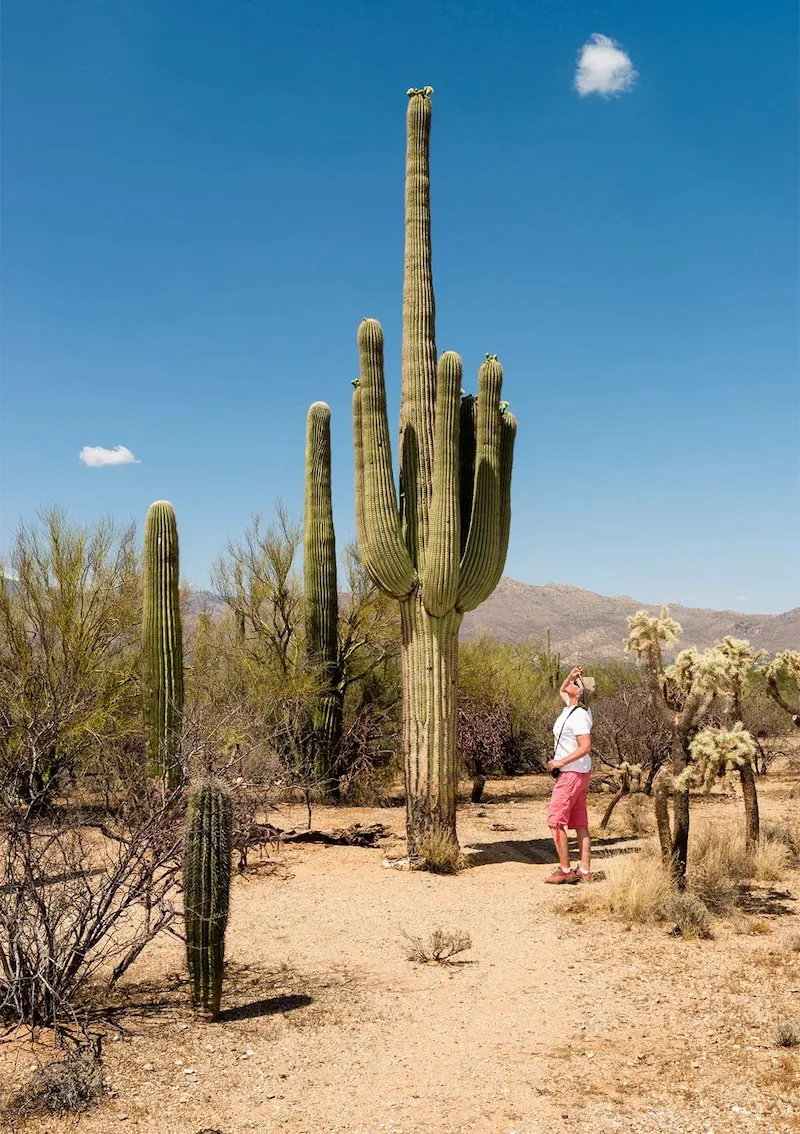Arizona, with its pristine beauty of sprawling deserts, majestic canyons, and unique indigenous culture, is always an attractive destination for tourists. However, the Arizona desert also harbors many dangers, requiring visitors to be fully equipped with survival knowledge and skills to ensure a safe trip. Are you ready to discover the secrets to conquering the Arizona desert safely and completely?
Exploring the Arizona Desert: Prepare Carefully for a Safe Journey
Desert travel is not just a trip, but also an adventure full of challenges. To face the harsh conditions of the Arizona desert environment, careful preparation is key. Let’s explore important survival tips so you can confidently discover this wild beauty.
Best Time to Explore the Arizona Desert
Weather is the most important factor to consider when planning a trip to the Arizona desert. Summer here is extremely hot, with temperatures possibly exceeding 40°C (104°F), posing a risk of heatstroke, dehydration, and exhaustion.
The best time to explore the Arizona desert is in the spring (March – May) and autumn (September – November). At this time, the weather is milder and more pleasant, suitable for outdoor activities such as hiking, climbing, and camping.
Essential Gear for Your Trip
To ensure safety and comfort throughout your journey, you need to prepare the following items:
- Drinking water: Always carry enough drinking water, at least 4 liters per person per day.
- Food: Choose energy-rich, easily digestible foods such as energy bars, nuts, and dried fruits.
- Clothing: Wear long-sleeved, breathable, light-colored clothing to protect your skin from the sun.
- Hat and sunglasses: Wear a wide-brimmed hat and sunglasses to shield your face and eyes from the harsh sun.
- Sunscreen: Apply high SPF sunscreen (SPF 30 or higher) regularly, even on cloudy days.
- Hiking boots: Choose shoes with good grip and comfort for walking on rough terrain.
- First aid kit: Bring a first aid kit with all necessary items such as bandages, antiseptic, pain relievers, and allergy medication.
- Compass, map, and GPS: Use a compass, map, and GPS to navigate and avoid getting lost.
- Multi-tool knife: A multi-tool knife is useful in many situations, from cutting food to repairing equipment.
- Flashlight: A flashlight is indispensable when moving in the dark.
- Lighter or matches: A lighter or matches can help you make a fire for warmth, cooking, or signaling for help.
- Whistle: A whistle is an effective tool to attract attention in case of emergency.
Plan Details and Notify Loved Ones
Before starting your journey, plan the route, campsites, and estimated time in detail. Share this plan with relatives or friends and notify them when you arrive at and leave important locations.
Essential Survival Skills in the Arizona Desert
In addition to preparing enough gear, you also need to equip yourself with basic survival skills to cope with emergency situations that may occur in the desert.
Finding Water Sources
Water is vital in the desert environment. If you run out of water, look for natural water sources such as:
- Streams and lakes: Look for streams or small lakes. However, remember to filter or boil the water before drinking to remove bacteria and parasites.
- Cacti: Some types of cacti, such as the barrel cactus, can contain water inside. Cut off the top of the cactus and crush the pulp to get water.
- Digging wells: Dig a small well in areas with signs of vegetation or dry riverbeds.
Building a Shelter
Shelter can protect you from harsh sunlight, strong winds, and extreme temperatures. You can build a shelter using natural materials such as branches, leaves, and rocks.
Making Fire
Fire can help you keep warm, cook food, boil water, and signal for help. To make a fire, you need to prepare tinder (such as dry grass, dry leaves, bark) and fire starters (such as lighters, matches, flint).
Navigating in the Desert
The desert can be very disorienting, especially when there are no clear landmarks. To navigate, you can use a compass, map, GPS, or observe the position of the sun and stars.
Recognizing Danger Signs
The Arizona desert is home to many dangerous animals such as venomous snakes, scorpions, and poisonous spiders. Be careful when moving and avoid contact with these animals. In addition, you also need to pay attention to the signs of heatstroke, dehydration, and exhaustion.

3. Emergency Response Skills
Even with careful preparation, you may still encounter unexpected emergencies in the desert. Here are some tips for dealing with common situations:
Getting Lost
If you get lost, stay calm and find a high position to observe your surroundings. Use a compass, map, or GPS to determine your location. If you do not have these devices, follow your footprints or find a trail to return.
Running Out of Water
If you run out of water, look for natural water sources as instructed above. Limit strenuous activity and find shade to minimize water loss.
Animal Attacks
If you are attacked by an animal, try to keep your distance and avoid provoking it. If bitten by a snake, give first aid by bandaging the wound tightly and trying to keep the bitten area lower than your heart. Call for emergency services or seek medical help as soon as possible.
Encountering Sandstorms
If you encounter a sandstorm, find a safe shelter such as a cave, rock crevice, or tent. Cover your face and eyes with a scarf or clothing to avoid getting sand in them.
Arizona Desert Travel Survival Tips: Safety is Paramount
Traveling in the Arizona desert is a wonderful experience, but also risky. By equipping yourself with sufficient knowledge, skills, and necessary gear, you can minimize the risk of encountering emergencies and enjoy a safe and memorable trip. Always remember, safety comes first!